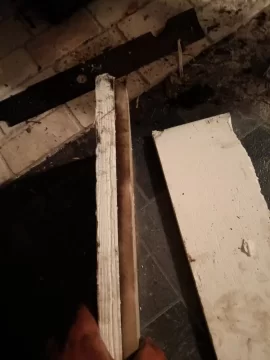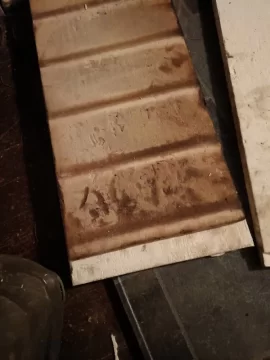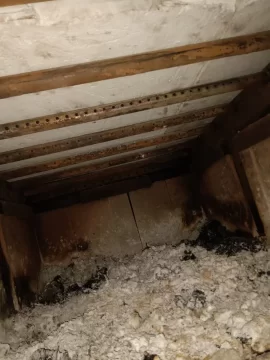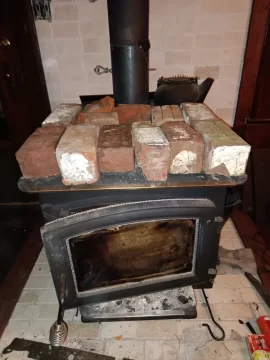Epa to smoke dragon conversion
- Thread starter Dunmyermowingllc
- Start date
-
Active since 1995, Hearth.com is THE place on the internet for free information and advice about wood stoves, pellet stoves and other energy saving equipment.
We strive to provide opinions, articles, discussions and history related to Hearth Products and in a more general sense, energy issues.
We promote the EFFICIENT, RESPONSIBLE, CLEAN and SAFE use of all fuels, whether renewable or fossil.
You are using an out of date browser. It may not display this or other websites correctly.
You should upgrade or use an alternative browser.
You should upgrade or use an alternative browser.
I really think you need to spend time just learning to use the stove and stop tinkering. I change stoves pretty often and honestly it takes a while to learn a new oneSo. Upgraded the ceramic board baffles from factory .5" to .75" I also cut them a bit bigger my theory being the bigger baffles will slow down the fire. Also added a bunch of solid bricks I'm assuming are original around the time of the house(1920) for thermal mass
View attachment 315534 View attachment 315535 View attachment 315536 View attachment 315537
I spent from December till end of last season fighting overfires on this stove. I was done with it in factory form. It was unsafeI really think you need to spend time just learning to use the stove and stop tinkering. I change stoves pretty often and honestly it takes a while to learn a new one
Ok and in response you completely changed everything instead of making small incremental changes.I spent from December till end of last season fighting overfires on this stove. I was done with it in factory form. It was unsafe
Yes but you also have eliminated all of the benefits of a modern stoveThat is correct. I think I would really have to try to get it to overfires now
I’ve been watching a guy over in the UK on YouTube testing Euro stoves and they all are non cats and seem to have way better control than what I see over here. Usually the baffles are slanted upwards with no secondary air tubes underneath. The secondary air seems to come from holes in the rear of the fire box. When he turns the air down there is an immediate slow down to a nice lazy flame. These stoves probably have better secondary control? Maybe they burn a little dirtier than ours over here but I bet the efficiency is similar.
I've watched a few of his videos. Seems more marketing focused than fact based.
The analogy is not necessarily correct. The company has a history of circumventing or abusing EPA regs and letting the consumer deal with the consequences. It's not an industry-wide equivalent.@weee123 if the government mandates it then yes. Take the vg3200 for example. Sure it had tubes in it but it's unsafe to use in reality, but it meets emissions. Just like newer diesel engines, the gov. Mandated less emissions and now we have unreliable, expensive to maintain diesels that get less fuel mileage then the old mechanical injection ones.
Correct. There is a secondary port in the very back of the stove built out of square stock that's integral to the stove that runs off the "boost" air the lever on the right on this stove. Watching last night she still gets some secondaries that run from back all the way to the glass if this lever is openYes but you also have eliminated all of the benefits of a modern stove
You are correct, more reputable companies seem to build much better products that are actually usable. Though I've seen many threads on here of people having to block off some air on better brands to. But that reference was mainly for this particular model of us stove. The 2000sqft us stove we had before this was great, 2021 model year I think? it never overfired. It has nice secondaries and was very controllable I never even needed a flue damper with that stove.The analogy is not necessarily correct. The company has a history of circumventing or abusing EPA regs and letting the consumer deal with the consequences. It's not an industry-wide equivalent.
You are correct, more reputable companies seem to build much better products that are actually usable. Though I've seen many threads on here of people having to block off some air on better brands to. But that reference was mainly for this particular model of us stove. The 2000sqft us stove we had before this was great, 2021 model year I think? it never overfired. It has nice secondaries and was very controllable I never even needed a flue damper with that stove.
If the previous stove was a 2021 stove it was built to meet the same regulations. The fact is this manufacturer generally just copies what others do without putting much of any effort into r&d or testing of their own. Sometimes they get it right and sometimes they get it really wrong. Their quality control is also severely lacking
EbS-P
Minister of Fire
The bricks won’t help and probably even make the stove run hotter. The thermal conductivity of brick is 10 times or more lower than steel. If heat can’t get out of the stove it just goes up the flue. I suggest removing bricksSo. Upgraded the ceramic board baffles from factory .5" to .75" I also cut them a bit bigger my theory being the bigger baffles will slow down the fire. Also added a bunch of solid bricks I'm assuming are original around the time of the house(1920) for thermal mass
View attachment 315534 View attachment 315535 View attachment 315536 View attachment 315537
Todd
Minister of Fire
I
Nevermind I didn’t see the pics at first but talking about thermal mass, I’ve seen where some people surround a stove with bricks or concrete blocks with a small gap between to add some thermal mass and even out the heat some. Not sure how good that would work, think you would need a good radiant stove? I was thinking of doing this for my 602 in my workshop.
Is he talking about bricks inside the stove or outside for some extra thermal mass?The bricks won’t help and probably even make the stove run hotter. The thermal conductivity of brick is 10 times or more lower than steel. If heat can’t get out of the stove it just goes up the flue. I suggest removing bricks
Nevermind I didn’t see the pics at first but talking about thermal mass, I’ve seen where some people surround a stove with bricks or concrete blocks with a small gap between to add some thermal mass and even out the heat some. Not sure how good that would work, think you would need a good radiant stove? I was thinking of doing this for my 602 in my workshop.
Last edited:
When stovetops around 600 the top of the bricks are about 200. After an hour or so. My theory is that the brick will retain lower heat for longer after. Than the steel does?
Yes it will retain heat longer. But delay heat output for equally as long there is really no benefit to be had. And by slowing the transfer off of that top you may actually loose some efficency.When stovetops around 600 the top of the bricks are about 200. After an hour or so. My theory is that the brick will retain lower heat for longer after. Than the steel does?
Once the cold weather comes maybe I'll do a test on similar overnight burns and see if there's any big difference on room tempsYes it will retain heat longer. But delay heat output for equally as long there is really no benefit to be had. And by slowing the transfer off of that top you may actually loose some efficency.
Todd
Minister of Fire
I think there’s a fine line when it comes to thermal mass. Too much and it sucks up a lot heat from your stove, too little and you won’t see any benefit. If your a 24/7 burner some extra thermal mass could help even out the heat and temp swings a bit. I live in a log cabin and my stove is tucked in a corner. All those logs are a lot of thermal mass and I think it helps some. This year I stacked a 1000 lbs of concrete pavers in the corner behind the stove for a little more thermal mass and to also protect the logs.
EbS-P
Minister of Fire
Thermal mass is good but it shouldn’t be touching the hottest part of the stove unless it has almost the same thermal conductivity. Heat must flow out of the stove not be trapped inside it (exception to parts of the stove where secondary combustion occurs)





